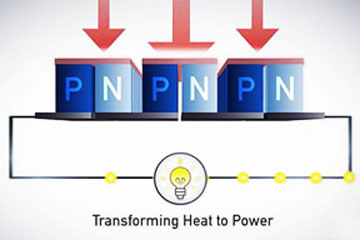It has been estimated that more than half of U.S. energy usage is wasted as heat — for instance, from vehicles and heavy equipment. Mostly, this waste heat simply escapes into the air. But that’s beginning to change, thanks to thermoelectric innovators such as Massachusetts Institute of Technologies Professor Gang Chen.
About a decade ago Chen, Professor of Power Engineering and head of MIT’s Department of Mechanical Engineering, used nanotechnology to restructure and dramatically boost the efficiency of one thermoelectric material. Using this method, GMZ Energy, a company cofounded by Chen and collaborator Zhifeng Ren of the University of Houston, has now created a thermoelectric generator (TEG). The 1-in.2 , 0.25-in.-thick module turns waste heat emitted by vehicles into electricity.

In a TEG, electricity is generated when heat moves through a semiconductor material to the cooler side of the module and the motion of electrons in the semiconductor under this temperature difference creates a voltage. However, in many TEGs atomic vibrations in the material can also leak heat from the hot to the cold side. GMZ’s method essentially slows the heat leakage, leading to a 30% to 60% increase in performance across many thermoelectric materials.
The company’s TEG can withstand temperatures of roughly 600°C on its hot side (top surface), while maintaining a temperature of 100°C on its cold side (bottom). With this gradient of 500°C, a module that’s 4 cm2 can produce 7.2 W. Installed near a car’s exhaust pipe, for instance, this converted electricity could power the car’s electrical components, reducing the load on the vehicle’s alternator.
In June, GMZ successfully generated 200 W from a larger TEG as part of $1.5 million program supported by the U.S. DOE. The goal is to eventually integrate multiple 200-W TEGs into the Bradley Fighting Vehicle to produce 1,000 W. More information is available at http://newsoffice.mit.edu and http://gmzenergy.com.
Advertisement
Learn more about Electronic Products Magazine





